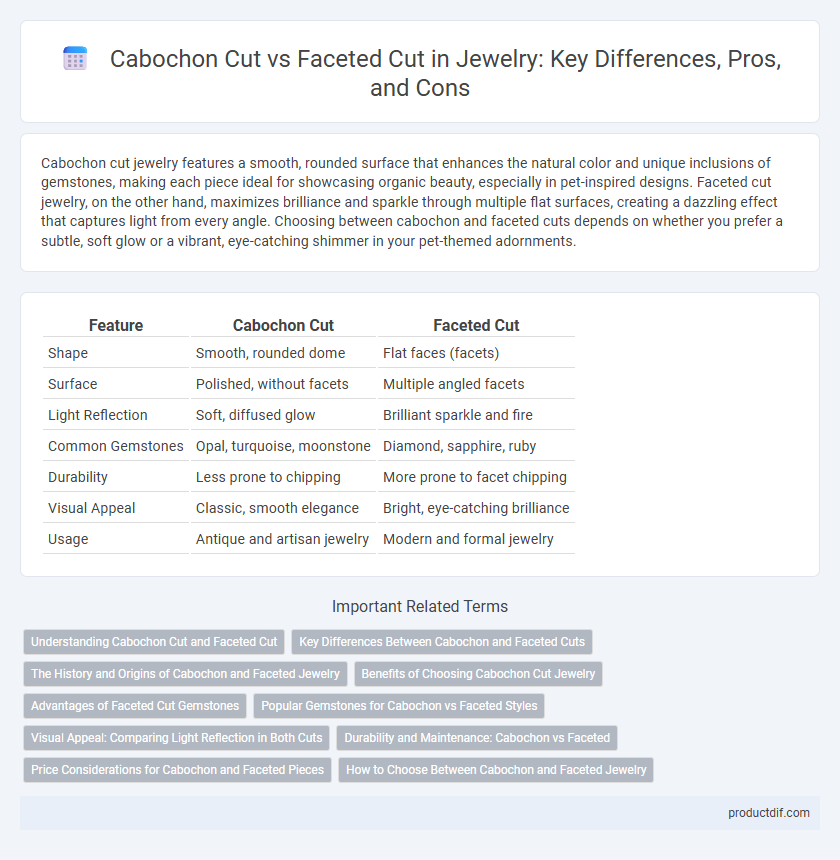Cabochon cut jewelry features a smooth, rounded surface that enhances the natural color and unique inclusions of gemstones, making each piece ideal for showcasing organic beauty, especially in pet-inspired designs. Faceted cut jewelry, on the other hand, maximizes brilliance and sparkle through multiple flat surfaces, creating a dazzling effect that captures light from every angle. Choosing between cabochon and faceted cuts depends on whether you prefer a subtle, soft glow or a vibrant, eye-catching shimmer in your pet-themed adornments.
Table of Comparison
| Feature | Cabochon Cut | Faceted Cut |
|---|---|---|
| Shape | Smooth, rounded dome | Flat faces (facets) |
| Surface | Polished, without facets | Multiple angled facets |
| Light Reflection | Soft, diffused glow | Brilliant sparkle and fire |
| Common Gemstones | Opal, turquoise, moonstone | Diamond, sapphire, ruby |
| Durability | Less prone to chipping | More prone to facet chipping |
| Visual Appeal | Classic, smooth elegance | Bright, eye-catching brilliance |
| Usage | Antique and artisan jewelry | Modern and formal jewelry |
Understanding Cabochon Cut and Faceted Cut
Cabochon cut gemstones feature a smooth, rounded surface without facets, enhancing the stone's color, natural inclusions, and luster, making them ideal for opaque or translucent materials like opal, moonstone, and turquoise. Faceted cuts, such as brilliant, princess, or emerald cuts, involve multiple flat surfaces meticulously angled to maximize light reflection and brilliance, commonly used in transparent gems like diamonds, sapphires, and rubies. Choosing between cabochon and faceted cuts depends on the gemstone's optical properties and the desired emphasis on color depth or sparkle.
Key Differences Between Cabochon and Faceted Cuts
Cabochon cuts feature a smooth, rounded surface without facets, showcasing the stone's natural color and inclusions, often used in opaque or translucent gemstones like moonstone and opal. Faceted cuts consist of multiple flat polished surfaces designed to enhance light reflection and brilliance, commonly applied to transparent gems such as diamonds, sapphires, and rubies. The key difference lies in cabochon cuts emphasizing shape and texture, while faceted cuts maximize sparkle and light performance.
The History and Origins of Cabochon and Faceted Jewelry
Cabochon cut jewelry, characterized by its smooth, rounded surface, dates back to ancient civilizations such as the Egyptians and Sumerians, who valued this technique for its ability to highlight the natural beauty of gemstones. Faceted cut jewelry emerged during the Renaissance, revolutionizing gem cutting by enhancing light refraction and brilliance through precise flat surfaces. The evolution from cabochon to faceted cuts reflects advances in lapidary technology and changing aesthetic preferences in the history of jewelry design.
Benefits of Choosing Cabochon Cut Jewelry
Cabochon cut jewelry offers a smooth, rounded surface that highlights the natural color and patterns of gemstones, making it ideal for opaque or translucent stones like opal, turquoise, and moonstone. This cut enhances durability by minimizing sharp edges, reducing the risk of chipping and making it suitable for everyday wear. Cabochon stones also provide a unique, vintage-inspired aesthetic that appeals to those seeking classic and understated elegance in jewelry designs.
Advantages of Faceted Cut Gemstones
Faceted cut gemstones exhibit enhanced brilliance and sparkle due to multiple polished surfaces that reflect and refract light, making them highly desirable for fine jewelry. This cutting style maximizes the gemstone's color and clarity, creating a visually captivating effect that increases perceived value. Faceted cuts also allow for a wider variety of shapes and sizes, offering greater design versatility for jewelry artisans.
Popular Gemstones for Cabochon vs Faceted Styles
Popular gemstones for cabochon cuts include opal, turquoise, and moonstone, as their smooth, rounded surfaces enhance the stones' unique color play and internal patterns. Faceted cuts are preferred for diamonds, sapphires, and emeralds to maximize brilliance and light reflection through precise geometric facets. Choosing between cabochon and faceted styles depends on the gemstone's optical properties and desired visual effect in jewelry design.
Visual Appeal: Comparing Light Reflection in Both Cuts
Cabochon cut features a smooth, rounded surface that emphasizes color and texture by reflecting light softly, creating a subtle glow ideal for opaque or translucent gemstones. Faceted cut, with its multiple flat surfaces, maximizes light reflection and refraction, producing brilliance and sparkle that enhance transparent stones. The choice between cabochon and faceted cuts significantly affects a jewel's visual appeal based on how each cut interacts with light.
Durability and Maintenance: Cabochon vs Faceted
Cabochon cut gemstones feature a smooth, rounded surface that enhances durability by reducing the risk of chipping and scratching, making them ideal for everyday wear and low-maintenance care. Faceted cut gems, with multiple flat surfaces designed to maximize sparkle and light reflection, require more careful handling and regular cleaning to maintain their brilliance and avoid damage to sharp edges. Jewelry experts recommend cabochon cuts for durability-focused designs and faceted cuts when brilliance outweighs maintenance concerns.
Price Considerations for Cabochon and Faceted Pieces
Cabochon cut gemstones generally command lower prices than faceted pieces due to simpler cutting techniques that preserve more of the rough stone, reducing material loss. Faceted cuts, designed to maximize brilliance and light reflection, often require more labor and skill, increasing their market value. Buyers should weigh the unique aesthetic appeal and budget, as cabochons offer affordability and smooth elegance, whereas faceted gems highlight sparkle at a premium cost.
How to Choose Between Cabochon and Faceted Jewelry
Choosing between cabochon and faceted jewelry depends on the gemstone's natural characteristics and desired aesthetic. Cabochon cuts, with their smooth, rounded surfaces, enhance opaque or included stones, highlighting color and patterns, while faceted cuts maximize brilliance and sparkle for transparent gems by creating multiple reflective surfaces. Consider the gem's clarity, color, and intended style to select the cut that best showcases its unique beauty.
cabochon cut vs faceted cut Infographic

 productdif.com
productdif.com